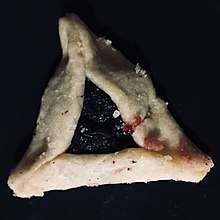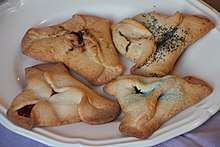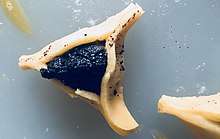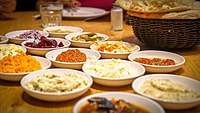Hamantash
A hamantash (pl. hamantashen; Yiddish: המן־טאַש homentash, pl. המן־טאַשן homentashn, literally 'Haman pockets') is an Ashkenazi Jewish triangular filled-pocket cookie, usually associated with the Jewish holiday of Purim. The name refers to Haman, the villain in the Purim story. In Hebrew, hamantashen are known as אוזני המן, oznei Haman, literally 'Haman's ears'.
 Mohn (poppyseed) hamantash. | |
| Type | Cookie or pastry |
|---|---|
| Place of origin | Ashkenazi Jewish communities |
| Variations | Filling: traditionally poppy seed |
The shape is achieved by folding in the sides of a circular piece of dough similar to a shortbread, with a filling placed in the center. Hamantashen are made with many different fillings, which are traditionally sweet (although savory varieties have become popular as well), including mohn (poppy seed, the oldest and most traditional variety), lekvar (prune jam), nut, date, apricot, raspberry, raisins, apple, vanilla pastry cream with chocolate chips[1] cherry, fig, chocolate, dulce de leche, halva, or even caramel or cheese.[2] Their formation varies from hard similar to a shortbread to soft doughy casings.
Etymology

In Yiddish, the word homentash is singular, while homentashen is the plural form. However, hamantashen is the more common word form among English speakers, even when referring to a single pastry (for example, "I ate a poppy seed hamantashen").[3][4]
Name and symbolism
Hamantash is also spelled hamentasch, homentash, homentasch, homentaschan, or even (h)umentash. The name hamantash is commonly viewed as a reference to Haman, the villain of Purim, as described in the Book of Esther. The pastries are supposed to symbolize the defeated enemy of the Jewish people.[5] The word tash means "pouch" or "pocket" in Yiddish, and thus may refer to Haman's pockets, symbolizing the money that Haman offered to Ahasuerus in exchange for permission to destroy the Jews. In Hebrew, tash means "weaken", and the hamantash may celebrate the weakening of Haman and the hope that God will weaken all of the enemies of the Jews.[6] Another possible source of the name is a folk etymology: the Yiddish word מאָן־טאַשן (montashn) for a traditional delicacy, literally meaning "poppyseed pouch",[7] was transformed to hamantaschen, likely by association with Haman or inclusion of the Hebrew article ha- (ה). In Israel, hamantaschen are called oznei Haman (Hebrew: אוזני המן), Hebrew for "Haman's ears" in reference to their defeated enemy's ears.
The reason for the three-sided shape is uncertain. There is an old legend that Haman wore a three-cornered hat.[8] Alternatively, the Midrash says that when Haman recognized the merit of the Three Patriarchs, his strength immediately weakened.[6] Naked Archaeologist documentarian Simcha Jacobovici has shown the resemblance of hamantaschen to dice from the ancient Babylonian Royal Game of Ur, thus suggesting that the pastries are meant to symbolize the pyramidal shape of the dice cast by Haman in determining the day of destruction for the Jews.[9] A simpler explanation is that the shape derives from traditional Jewish baking techniques in Central Europe for folding dough so as to form a pouch around a filling, also common for making dumplings. It has also been suggested that the shape is a representation of female reproductive organs, and that the poppy-seed filling is a fertility symbol.[10][11]
Sweet fillings
Sweet hamantaschen fillings range from the traditional such as mohn/poppy seed, lekvar/prune, apricot jam, and also date which is especially popular in Israel.[12]
Prune
Prune hamantaschen was invented in 1731 by David Brandeis of Jung-Bunzlau, Bohemia. The daughter of a Christian bookbinder purchased from Brandeis povidl (plum jam) which she claimed had made her family ill; as her father coincidentally died a few days after eating it. The burgomaster of the city ordered the closure of Brandeis' store and imprisoned him, his wife, and son for selling poisonous food to Christians. Investigations by municipal authorities and the court of appeal in Prague revealed that the bookbinder had died of consumption and the charges were dismissed. Brandeis wrote a scroll which he called Shir HaMa'alot l'David ("A Song of Ascents to David"), to be read on 10 Adar, accompanied by a festive meal. He was freed from prison four days before Purim after the charges against him were proven to be false, and in celebration of his release, Jews from his city celebrated with povidl or plum hamantaschen. [13][14]
Vanilla pastry cream with chocolate chips

Israeli baker Uri Scheft offers hamantaschen filled with a vanilla pastry cream and chocolate chips at Lehamim/Breads Bakery, his bakeries in Tel Aviv and New York City. A recipe for this filling is also featured in Scheft's cookbook.[15]
Savory fillings
Savory hamantaschen fillings have emerged in recent years, and their popularity has grown and are commonly prepared at home but can also be found in various Jewish bakeries and restaurants serving Jewish cuisine. Savory varieties may have fillings such as pizza, spinach and feta, lamb, potato, or cheese, and are often somewhat similar to other Jewish pastries such as the knish, bourekas, and sambusak.[16]
Preparation
.jpg)

Sweet hamantaschen are typically made with a dough containing butter or, less-commonly a pareve dough containing oil. Depending on the ingredients used in the dough, the consistency of the finished hamantaschen can range from dry and crumbly like to a shortbread, to soft and cakey like a black and white cookie, to firm and crisp like a butter cookie. The dough is generally prepared with flour, eggs, sugar, butter (or margarine or cooking oil), and a flavoring such as vanilla (or sometimes cocoa, rose water, or orange blossom water may be used); sometimes milk is used in the dough, and sometimes a leavener such as baking powder or baking soda is added as well. The dough is then mixed gently so as to incorporate all the ingredients together but not make the dough tough and give the hamantaschen an inferior texture.[17]
The dough is allowed to rest in the refrigerator and is then removed and rolled out to a thickness of between 1/8 and 1/4 of an inch; rounds of dough are stamped out and are often brushed with an egg wash to encourage sealing prior to the addition of the filling. The most popular filling is poppyseed[18], but apricot, prune, strawberry, raspberry, chocolate, peanut butter and jelly, and others are also common. The bottom and the top two corners of the dough are folded inward but do not fully enclose the filling, allowing it to remain visible. Sometimes hamantaschen may be frozen for a short period of time after shaping in order to prevent leakage of the filling. Then they are baked in an oven at medium heat for a short duration of time. Sometimes after baking hamantaschen may be dusted with confectioner's sugar, dipped in melted chocolate, or topped with sprinkles.[19]
Savory hamantaschen are prepared in much the same way as sweet hamantaschen, with the exception of the fillings; and they are generally made with a different dough, such one similar to a pie crust or puff pastry, or a modified sweet hamantaschen dough containing less sugar.[20]
Hamantashen in Israel

"In recent years, Israeli bakeries have increasingly offered gourmet versions of the three-cornered cookie — marzipan, say, or gluten-free varieties — alongside the classics, like poppyseed. The change reflects the growing sophistication of Israel’s culinary scene, which is focused on updating traditional dishes and fusing them with cuisines from around the world."
.jpg)
Hamantaschen are known as "oznei haman" in Israel, and are the most popular cookie sold at bakeries across Israel in the weeks leading up to the celebration of Purim each year, with both large chains and small independent bakeries offering many different varieties. As in the diaspora, poppyseed remains the most-popular filling, with chocolate in second, and date filling coming in third in popularity. Jam is not nearly as common a filling as in America.[22]
Each year bakeries offer new, innovative flavors of hamantaschen. Roladin, a popular Israeli bakery chain offers oznei haman with fillings such as goat cheese and onion jam, amaretto-pistachio-marzipan, and triple-sec cheesecake, among others. In 2017, Roladin announced that they were launching a dozen new flavors as well as reinvented versions of the more traditional fillings, and projected that they would sell over 2 million oznei haman during the Purim season. Lehamim Bakery, which has locations in Tel Aviv and New York City offers fillings such as sweet potato and feta, charoset, vanilla pastry cream with chocolate chips, apple, marzipan, and others. Oren Becker, an Israeli pastry chef has started making gluten free, vegan low or no-sugar, and low fat hamantaschen, and has said his personal favorite is made with a whole grain dough and filled with goji berries.[23]
See also
- Latke–Hamantash Debate
- Ashkenazi Jewish cuisine
- Israeli cuisine
- American Jewish cuisine
- Culture of Israel
- Ma'amoul- a similar Mizrahi Jewish filled cookie traditionally served for Purim
- Jam tart
References
- Scheft, Uri. Breaking Breads. Artisan Books.
- "Epi Log: The latest in Food News, the Culinary Arts & Cooking". Archived from the original on 2012-06-30. Retrieved 2007-03-25.
- Rosenthal, Leonard (22 February 2013). "All about hamantaschen". San Diego Jewish World. Donald H. & Nancy E. Harrison. Retrieved 28 September 2016.
...that does not stop people from using the plural even when they are referring to the singular...
- Pelaia, Ariela. "Why Do Jews Eat Hamentaschen During Purim?". Learn Religions. Retrieved 2020-03-10.
- Purim, Jewish Encyclopedia, 1906, 'In this connection it may be mentioned that for the celebration of Purim there developed among the Jews a special kind of baking. Cakes were shaped into certain forms and were given names having some symbolic bearing on the historical events of Purim. Thus the Jews of Germany eat "Hamantaschen" and "Hamanohren" (in Italy, "orrechi d'Aman"), "Kreppchen," "Kindchen," etc.'
- Shurpin, Yehuda. "The History and Meaning of Hamantaschen". Chabad.org. Retrieved March 2, 2018.
- MyJewishLearning.com - Holidays: Purim Foods Archived 2007-03-02 at the Wayback Machine
- Lewinsky, Yom Tov (1958). Sefer Hamoadim. p. 154. Retrieved March 2, 2018.
- Gordon, Dave (April 8, 2011). "Filmmaker unearths mystery". Jewish Independent. Archived from the original on March 14, 2014. Retrieved March 13, 2014.
- Schnur, Susan (Spring 1998). "From Prenistoric Cave Art To Your Cookie Pan: Tracing The Hamantasch Herstory" (PDF). Lilith. 23 (1): 22–4.
- Kaplan, Arielle. "Yes, There's a Reason Hamantaschen Look Like Vaginas". Alma. Retrieved 8 March 2020.
- Scheft, Uri. Breaking Breads.
- Sacharin, Emily. "A Purim Classic: Sugar Cookie Hamantaschen". Poppy and Prune. Retrieved 15 March 2020.
- "Purims, Special". Jewish Encyclopedia. Archived from the original on 4 March 2016. Retrieved 15 March 2020.
- Scheft, Uri. Breaking Breads.
- Sarna, Shannon. The Modern Jewish Baker.
- Scheft, Uri. Breaking Breads.
- Scheft, Uri. Breaking Breads.
- Nathan, Joan. The Jewish Holiday Cookbook.
- Sarna, Shannon. The Modern Jewish Baker.
- Tobin, Andrew. "Israeli chefs take hamantaschen to a whole new level". The Times of Israel. Retrieved 15 March 2020.
- Tobin, Andrew. "Israeli chefs take hamantaschen to a whole new level". The Times of Israel. Retrieved 15 March 2020.
- Tobin, Andrew. "Israeli chefs take hamantaschen to a whole new level". The Times of Israel. Retrieved 15 March 2020.
